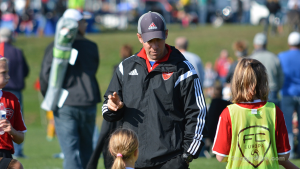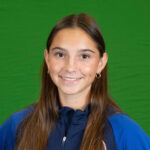Dure: U.S. Soccer coaching curriculum leaves parent coaches in a jam
 This weekend, I should be going out to Loudoun County, Virginia to take the “evaluation weekend” for the U.S. Soccer D coaching license.
This weekend, I should be going out to Loudoun County, Virginia to take the “evaluation weekend” for the U.S. Soccer D coaching license.
Pre-holiday plans are one reason I won’t make it. The other reason is more structural, and it shows how much more progress we need to make to get coaching education where we want it in this country — accessible, widespread and informative.
It’s not the fault of the excellent Virginia Youth Soccer Association staff, and I could’ve prepared better. Still, the structure of this license is difficult to manage for a parent coach like me, and that’s an issue that affects the grass roots of this game.
The D license is taught over two weekends. The first is the “instructional weekend,” which has a bit of classroom time and a bit of time on the field. The instructors demonstrate a few things, and then we the candidates run one short practice session each. The second weekend, months later, is the “evaluation weekend,” and that’s all about doing it on the field.
+READ: Dure: We don’t need no (Academy) education?
In between, we have Phase III: Deliberate Practice Phase. Candidates are supposed to do three training sessions, selected from a list of themes and presented in a complex spreadsheet. The themes are good practice topics for a moderately advanced U-14 team.
So what do you do if you’re not coaching such a team?
It’s a Catch-22 situation of sorts. To learn to coach a U-14 team, you should already be coaching a team at that level. I coached a U-12 recreational team this season, and we worked on technical fundamentals, not the more advanced, more tactical themes U.S. Soccer lists.
Good instructors will work with candidates, of course, to figure out ways to make this work. Maybe my session on passing into space could be a rough fit for “Improve your team to build up using wide players.”
But it’s an awkward fit, and after a while, the message sinks in: This class isn’t for me or other recreational coaches.
(I did once float the idea of making a little extra money by coaching a travel team. That idea did not make it past my front door.)
 It’s already inconvenient. The D license weekends are offered a couple of times a year, not necessarily near where you live. If your main job is in something other than soccer, it’s arguably easier (but much more expensive) to get an MBA than it is to get a coaching license.
It’s already inconvenient. The D license weekends are offered a couple of times a year, not necessarily near where you live. If your main job is in something other than soccer, it’s arguably easier (but much more expensive) to get an MBA than it is to get a coaching license.
Most of the coaches in my D license class, though, weren’t in the same boat as me. We had a couple of fellow parents, but we also had a wide range of professional coaches, some of them already with a lot of responsibility. We had a player/coach for a WPSL team who scored a couple of fantastic goals in our demonstration sessions. (I, on the other hand, aggravated an Achilles/plantar fascia injury that means I will not be participating in such sessions again.)
+READ: Dure: Presenting the FREE education plan for parent coaches
So for coaches who are on the pathway to professional careers, perhaps moving on to get B and A licenses down the road, this course is a natural fit.
What about the rest of us?
At the youngest ages, U.S. Soccer has made progress. The F license is now online, and it’s terrific. Some of the topics are a little dry, and I’m still wondering what parents are asking soccer coaches to advise them on how long their kids should sleep. (Also, I was stunned that a nutritionist recommended peanut butter for postgame snacks — any parent today knows that nut products in youth group settings are an absolute no-no thanks to allergy concerns.) But I could watch Vince Ganzberg and should-be Hall of Famer Shannon MacMillan run training sessions for U-8s all day.
That’s great. But I still feel like I have a lot to learn. In a previous column, I suggested a few topics for parent coaches — everything from dealing with special-needs kids to “advanced shoe-tying.” A couple more:
How do I teach heading? That’s not really covered, and it’s an important safety issue.
How do I adapt training sessions when I have some players at a travel level and some who are totally new?
What do I do when my club’s new curriculum is telling me to start the season with a dribbling exercise that has them “handing off” the ball to teammates, when I know my players really need to learn to spread out and pass the dadgum ball?
+READ: Dure: Age-group issue puts Development Academy in a time warp
To be fair, U.S. Soccer has already hit the most crucial age group for parent coaches — U-8 and below, where most of the coaches are going to be volunteers. By U-14, perhaps the needs of recreational players are just different. Maybe we need a separate “rec license” above the E license.
But there’s also a value in helping more people get through advanced courses. Maybe even if they’re just “auditing.” I learned a lot from the D license instructional weekend, so even if I never get the piece of paper telling me I have a D, I don’t think I wasted my money. Simply drawing together instructors and other coaches to kick around ideas is beneficial.
 Maybe we need some classes for writers and commentators. Even if they’re former players. I can think of quite a few TV commentators who would benefit from taking a refereeing class in addition to an E or D license coaching course.
Maybe we need some classes for writers and commentators. Even if they’re former players. I can think of quite a few TV commentators who would benefit from taking a refereeing class in addition to an E or D license coaching course.
One of the working groups that spun out of last week’s extraordinary summit meeting between U.S. Youth Soccer, AYSO and U.S. Club Soccer is on coaching education. Hopefully, they’ll spare a thought for those of us who are going to keep coaching recreational soccer through the middle school and high school years and would like to do it right.
##
Beau Dure’s new book, Single-Digit Soccer: Keeping Sanity in the Earliest Ages of the Beautiful Game, is now available in paperback at Amazon and in electronic form at Amazon, Barnes and Noble, and other online booksellers. Read more about it at SportsMyriad.
SOCCERWIRE MARKETPLACE
- visitRaleigh.com Showcase Series 2025, hosted by NCFC Youth
- OFFICIAL MANCHESTER CITY SOCCER CAMPS
- Wanted Licensed Youth Soccer Coach
- Join Official Elite Summer Soccer Camps with Europe’s Top Pro Clubs!
- The St. James FC Travel Staff Coach - North (Loudoun) & South (Fairfax)
- The St. James FC Girls Academy (GA) Head Coach - 2 teams
- The St James FC Boys Travel Tryouts
- OFFICIAL BAYERN MUNICH SUMMER CAMPS U.S.
- JOIN THE ALLIANCE!
- OFFICIAL FC BARCELONA CAMPS U.S.











